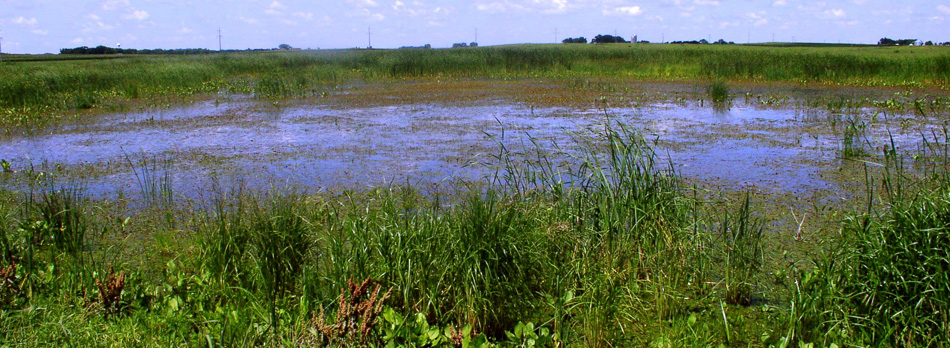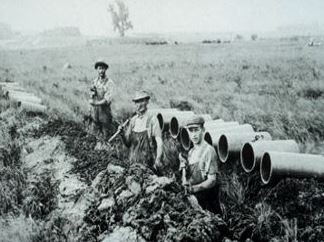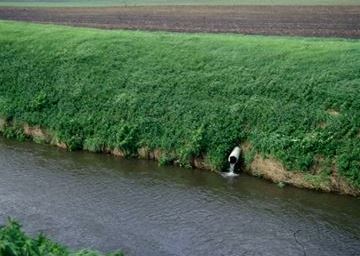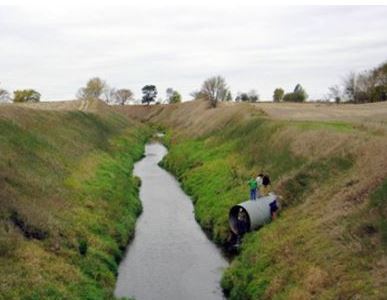Chris Jones is a research engineer (IIHR-Hydroscience and Engineering) at the University of Iowa. An earlier version of this piece was first published on the author’s blog. -promoted by Laura Belin
The Landscape of Capitalism by former University of Iowa professor Robert F. Sayre (1933-2014) is an excellent short history of Iowa agriculture. I read Sayre’s essay many years ago and had all but forgotten it, but it was restored to my memory recently by a conversation I had with an ag drainage engineer.
Sayre describes in his essay how the wetlands of Iowa, Illinois, Indiana, Michigan, Minnesota and Ohio once covered an area larger than Lakes Superior, Huron, and Michigan combined. Well over 90 percent of this wetland area has been drained for agriculture, and that figure is greater than 97 percent in Iowa.
Drainage of wetlands and lakes and an overall lowering of the water table happened gradually from 1850 to 1950, and was achieved by networks of underground drainage pipes (tiles) and constructed ditches. A task this great required much more capital than what early farmers had (many had almost nothing). Thus, much of the earliest drainage was financed by large capital investors from the East coast and England, who then made a killing by selling off individual tracts of the “improved land” to smaller farmers. Sayre wrote that the draining of the prairies could be considered one of the great accomplishments of American private capital.
He also wrote that nothing else better illustrates the conflict between economics and ecology.

Iowa pothole wetland. Image credit: U.S. Fish and Wildlife Service
At least from the perspective of crop production, drainage was wildly successful from the very beginning. In the 1920s William Berry, a professor at what was to become the University of Northern Iowa, wrote that drained land generated a surplus of grain and “has so upset farming conditions as to threaten the foundations of agriculture” as farmers struggled through low prices and the farm depression of that decade (1).

Installing field tiles in Boone County, circa 1914. Image credit: M.J. Bennet, University of Iowa Press.
Many people, including Sayre, have wondered if tile drainage affects flooding. The short answer is probably not much, at least within the context of large floods like 1993 and 2008. There is evidence that tile modestly reduces peak flows in some situations. Sloan et al. (2016) stated,
“…there exists a threshold rainfall magnitude (5–6 cm/day for most Iowa soils) over which there is minimal effect of subsurface drainage. For smaller events, tiling routes the flow through the subsurface and keeps the soil drier, which increases infiltration and reduces surface runoff while increasing subsurface flow.”
Other research has reached a similar conclusion.
Sloan also stated, however, that “For very large storm events, the rainfall magnitude and intensity are so high that surface runoff dominates, irrespective of the antecedent conditions created by the tile drains,” essentially saying tile drainage has no effect in these situations.
Tile drainage does appear to substantially increase total stream flow over the course of a year. Schilling and Helmers (2008) found that tile drainage “increases annual baseflow (flows between rainstorms) in streams, with seasonal increases primarily in the late spring and summer months. Thus, tile drainage….may have been a significant contributor to increasing baseflow in Iowa’s streams over the 20th century.” Other research in Iowa and Minnesota has shown much the same thing, with tile increasing annual flows by 30 to 50 percent over the last century.
This increased baseflow component is especially important for water quality, since this is the main hydrological driver of stream nitrate. We’ve known this in Iowa since at least 1975 (4) and probably long before that. Nitrate-nitrogen is an important contributor to the Gulf of Mexico dead zone and impairment of water resources and drinking water in Iowa. Our state policies have at times recognized the threat to drinking water and about $16 million of state money has been spent closing ag drainage wells, which were designed long ago to direct tile water downward to underground aquifers, a practice we eventually realized was contaminating rural well water. Most of those discharges are now directed out to streams like the Raccoon and Des Moines Rivers, which of course are municipal drinking water supplies for downstream cities where water customers pay to have the nitrate removed from their water.

Typical Iowa field tile discharging to constructed drainage ditch.
Back to my ag drainage engineer friend. He posted on social media that I claim tile causes flooding (I never say this). This resulted in a lively discussion about tile drainage in general. He was adamant about tile reducing flooding and stated that installing more tile would do “far more for flood reduction than anything the Iowa Watershed Approach will.” The Iowa Watershed Approach is a collaborative program that brings together local, state, federal, and private organizations to work together to address factors that contribute to floods and nutrient flows. The project, supported by U.S. Housing and Urban Development (HUD) leverages the principles of Iowa’s Nutrient Reduction Strategy to make Iowa more resilient to flooding and help improve water quality through implementation of practices that restore some natural function to the landscape.
My statement to the drainage engineer that “for long-term, resilient ecological improvements, we need to restore natural function to the landscape,” was greeted with “this Nirvana of yours is all very radical and unachievable without destructive political and social upheaval.” (I’m not kidding). Such is the exalted place occupied by Tile in the Church of Iowa Agriculture, at least in the eyes of some.
According to Sayre, a few folks did object to the first drainage on ecological grounds and drainage advocates attacked them as “enemies of progress.” That said, I believe it would be a mistake to think that the early drainers could have understood the full magnitude of what they were doing.
As we go forward installing more tile, however, we do so with a complete awareness of the ecological consequences. There can be no doubt about it. And I agree with Sayre when he says that the continuation of drainage is not driven by the well-being of the land or the need of the world for food, but rather by the need of owners of capital to increase it.

Large tile main in North Central Iowa. Trapezoidal ditch was likely constructed using steam shovel around 1900. Image credit: Iowa State University.
As I encounter people in agriculture, many times they feel compelled to tell me about the production benefits of tile, often with zeal and conviction. Believe me, I get it. We have known for an entire century that tile does a fantastic job of creating habitat for Zea mays L. (corn) and Glycine max (L.) Merr. (soybeans) and maybe some invasive weeds, but not much else. And we’ve known for half a century that it increases stream nitrate, sometimes by large amounts (4).
As we try to improve Iowa streams through taxpayer-funded cost-share programs that target nitrate loss, we also are charging full speed ahead expanding and enlarging the drainage infrastructure that we know with a certainty helps drive the problem in the first place.
I’ve relied heavily on Sayre for this piece and there’s not much point in stopping that now. He points out that both the public and private sectors have sought to promote prosperity by draining Iowa. Our century-old policies have regarded water as a public nuisance and only dry farm land as economically beneficial. The problem we have here is that this has been a zero-sum game when it comes to native species, the environment and our drinking water. Is there a limit to what we can wring out of this place called Iowa? I don’t have the answer to that question, but I do know that we are trying really hard to find out.
1) Berry, William J., 1927. The influence of natural environment in North-Central Iowa, Iowa Journal of History and Politics, 25, 290-305.
2) Sloan, B.P., Mantilla, R., Fonley, M. and Basu, N.B., 2017. Hydrologic impacts of subsurface drainage from the field to watershed scale. Hydrological processes, 31(17), pp.3017-3028.
3) Schilling, K.E. and Helmers, M., 2008. Effects of subsurface drainage tiles on streamflow in Iowa agricultural watersheds: Exploratory hydrograph analysis. Hydrological Processes: An International Journal, 22(23), pp.4497-4506.
4) Baker, J.L., Campbell, K.L., Johnson, H.P. and Hanway, J.J., 1975. Nitrate, Phosphorus, and Sulfate in Subsurface Drainage Water 1. Journal of Environmental Quality, 4(3), pp.406-412.



6 Comments
Good point
This is true, even though Iowa farmers like to think they are needed to feed the world: “drainage is not driven by the well-being of the land or the need of the world for food, but rather by the need of owners of capital to increase it.”
To increase it, or maybe just to retain it. My own land has much less tile than is readily feasible. This year corn did not get planted until June and will not be knee high tomorrow. It may not produce enough to pay for operating costs this year.
iowavoter Wed 3 Jul 8:43 PM
Thank you for your thoughtful response
Thank you for reading the essay and your thoughtful comment.–CJ
ankenydem Thu 4 Jul 8:22 AM
I've talked with two farmers in different townships who said...
…that they added more tile to their farms partly because adding tile was very good for soil and water. According to them, the added tile reduced the amount of surface runoff and therefore the additional tiling reduced water pollution and soil erosion. Both said that adding more tile was “very good for conservation.” Both their farms are basically flat. Neither farmer uses cover crops or edge-of-field practices that reduce nitrates in tile-drained water.
Now I wonder if Iowa farmers are getting conflicting information, or at least very-differently-slanted information, about what tiling actually does to water quality. I’m guessing that businesses that design, sell, and install tile-drainage upgrades don’t have a strong incentive to tell the whole story.
PrairieFan Thu 4 Jul 11:10 AM
thanks for reading
The Soil Conservation Service and later NRCS of USDA both promoted tile drainage as a conservation practice for many years, probably at least until the 1960s, and in fact Sayre talks about USDA promoting it in his essay. Many farmers do believe tile is a conservation practice. At this point in time, however, my feeling is that mindset is a rationalization for doing something that clearly has negative environmental consequences. The soil erosion benefits are likely confined to sloped areas where the need for tile is less anyway.
Make no mistake about it–tile pays for the farmer and the banks will readily loan money for new tiling. The effect probably does diminish with time.
As far as soil health, the natural condition of these soils is hydric–meaning they were formed in a saturated condition. If by “soil health” we mean suitable for corn and soybean production, then yes, tile promotes soil health. Dry soils compact less easily than wet ones when large equipment is driven across a field, this is also a component to the soil health argument.
Saturated soils result in nitrogen fertilizer being transformed to gaseous forms of nitrogen which then escape to the atmosphere, a process known as denitrification. Farmers lose some of their inputs as a result of this process. When the soils are dried out with tile, this process is reduced.
Tile also aerates the soil which can cause a mineralization of organic matter. This can be good for crops but bad for the soil in some situations.
Long and short, if we are going to insist on farming wet areas for c/sb, then they are going to need to tile. The industry benefits, but the public is left with tolerating or mitigating the negative environmental consequences. In a nutshell, this is the theme of the Sayre essay.
ankenydem Fri 5 Jul 8:32 AM
The piece below was published just a year ago...
…but as a defense of tile drainage, it has a certain timeless quality.
https://www.farmprogress.com/water/5-myths-about-farm-field-tiling
PrairieFan Mon 8 Jul 1:59 AM
Soil moisture needs of a third crop
Excellent piece. Please continue to post on this and other topics.
Hemp is said to be a candidate as a third crop for Midwest farmers. I was wondering if your research provides any sense of what the soil moisture needs of this crop would be? What of hemp’s impact on soils, conservation practices and input needs? Maybe too much to hope for that a third crop would provide some way out of the mess that monocultures are making. Alas, hemp will probably be more of the same.
JohnMorrissey Fri 5 Jul 10:29 AM